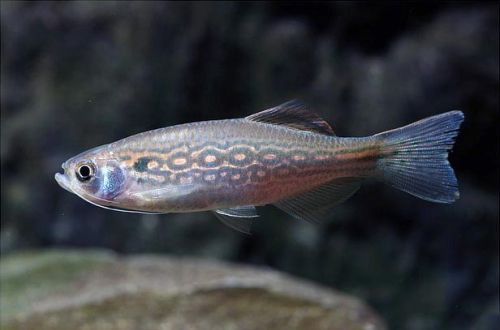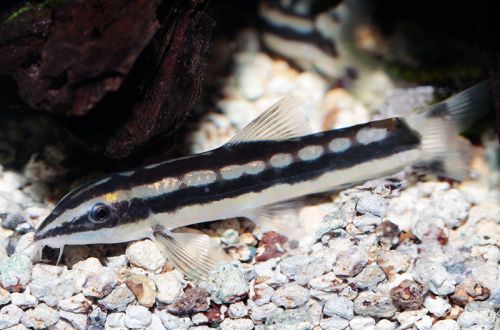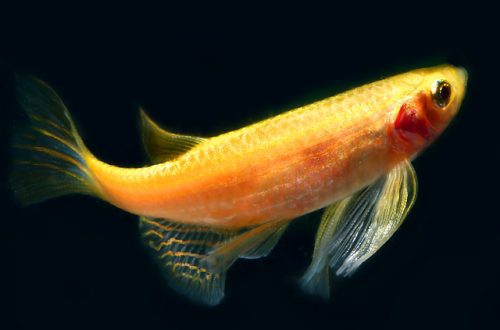
Mustachioed Danio
Danio Dangila or Mustachioed Danio, scientific name Danio dangila, belongs to the family Cyprinidae (Cyprinidae). The fish is distinguished by the presence of a long mustache, which is noticeably longer than that of other Danios. Easy to keep, relatively unpretentious and compatible with many other peaceful fish.

Contents
Habitat
Initially, it was believed that the habitat of this species covers the entire basin of the Ganges River in the territory of modern India. However, later studies have not confirmed this assumption. Currently, the habitat data refers to the Brahmaputra River, which flows through the eastern states of India and along the whole of Bangladesh.
The fish is found both in mountain rivers with a moderate course, and in swampy areas with dense aquatic vegetation.
Brief information:
- The volume of the aquarium – from 200 liters.
- Temperature – 16-24°C
- Value pH — 6.5–7.5
- Water hardness – 2–15 dGH
- Substrate type – any
- Lighting – any
- Brackish water – no
- Water movement – light or moderate
- The size of the fish is 6–13 cm.
- Food – any food
- Temperament – peaceful
- Keeping in a group of 8-10 individuals
Description
Adult individuals reach a length of 6-13 cm. The sizes depend on the specific region of origin, in the upper reaches of the rivers the fish are smaller, closer to the mouth, where wide floods and vast backwaters are larger. The coloration is silvery, the body pattern consists of wavy lines and spots. A characteristic feature is the presence of black spots located behind the gill cover, as well as long filamentous processes – whiskers, the presence of which is reflected in the name of this species.
Food
Easy to feed, most popular aquarium fish foods (dry, freeze-dried, frozen, live) will be accepted in the home aquarium.
Maintenance and care, arrangement of the aquarium
A flock of a dozen fish will need a spacious aquarium. A volume of 200 liters is considered the minimum allowable. Since in nature the fish inhabits various biotopes, the choice of design is limited only by the personal taste of the aquarist. The main condition is the presence of a large free space for swimming.
When keeping Baleen Danios, it is important to ensure stable water conditions, namely: to prevent the accumulation of organic waste (food residues, excrement), to maintain the acceptable range of pH / dGH and temperatures. Aquarium maintenance includes several standard procedures: equipment maintenance, weekly replacement of part of the water (20–40% of the volume) with fresh water, cleaning of the soil and design elements.
Behavior and Compatibility
Mobile schooling fish, it is recommended to maintain a group size of at least 8-10 individuals. Compatible with other non-aggressive freshwater species of comparable size. When choosing neighbors, it should be borne in mind that not everyone will be comfortable with a too active Danio.
Breeding / breeding
Breeding in a home aquarium is quite possible. In favorable conditions, spawning will occur regularly. Fish scatter eggs directly on the ground or in thickets of plants. The incubation period lasts about 48 hours, after another two days the fry begin to swim freely.
It is worth noting that the survival rate of fry in the general aquarium will be minimal. They will fall prey to adult fish and will have difficulty finding suitable food. In order to preserve the offspring, a separate tank is used with identical water conditions, where fertilized eggs or fry that have already appeared are placed. It is equipped with a simple airlift filter with a sponge as a filter material and a heater. A separate light source is not required, the light coming from the room will be enough. Arrangement is optional.
Feed with specialized powdered feed, if available – Artemia nauplii. They grow quickly, in a month they reach a length of up to one and a half centimeters.
Fish diseases
In a balanced aquarium ecosystem with species-specific conditions, diseases rarely occur. Often, diseases are caused by environmental degradation, contact with sick fish, and injuries. If this could not be avoided and the fish shows clear signs of illness, then medical treatment will be required. Read more about symptoms and treatments in the Aquarium Fish Diseases section.





